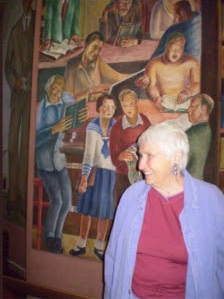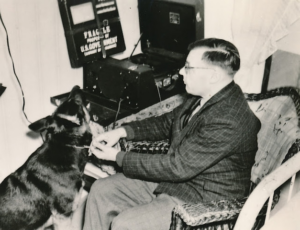
The description for this 1938 photograph reads, “The blind man is listening to one of the “talking book” records in his home, selected and mailed by a WPA library project worker. A talking book “not only talks and reads, but can present complete dramas with full Broadway casts, chirrup bird songs and calls of wildlife, and in other ways take full advantage of the fact that it is written in sound.” Courtesy, NARA.
Over fifty years before the Americans with Disabilities Act, the New Deal undertook the first major federal effort to aid citizens with physical and mental challenges. Between 1933 and 1943, mainly through the Works Progress Administration (WPA), thousands of New Deal works projects were directed at expanding, improving and staffing disabled services around the country. Facilities for the disabled were among the most elegant public works built in that era.
The New Deal was an especially transformative period for blind Americans. On June 20, 1936, President Franklin Roosevelt signed the Randolph-Sheppard Act, providing economic opportunities and services for the visually impaired. The legislation gave those qualified priority over other vendors to operate concessions, so-called “vending facilities,” on federal properties, including on military bases.
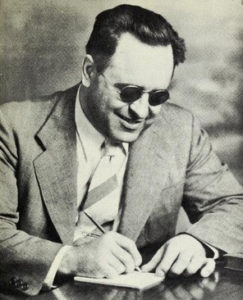
Joseph Clunk, the first blind civil servant in the federal government, was appointed in 1937 to administer the Randolph-Sheppard Act and serve as a “special agent for the blind.” Courtesy American Printing House for the Blind, sites.aph.org.
The passage of the Randolph-Sheppard Act also motivated legislatures in nearly every state to craft similar laws, referred to as ‘mini-Randolph-Sheppard Acts.” These federal and state initiatives today provide economic opportunities to more than 2,500 individuals.
The first blind civil servant, Joseph Clunk, (1895-1975), was hired a year later. Working in the federal Office of Education, Clunk’s main duty was to administer the new law. It seems he held this role until at least 1949, when he became Managing Director of the Philadelphia Association for the Blind.
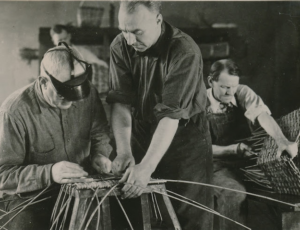
The WPA provided employment and training of blind workers in Atlanta, Georgia, in the production of goods like brooms, baskets and rugs, some of which were distributed to low-income Americans. Courtesy, NARA.
Many blind Americans found employment in the WPA, where they received instruction in various occupations. The WPA photograph collection at the National Archives reveals many such projects implemented to help the blind become more self-supporting. For example, WPA workers transcribed books into Braille using Braille writers, a machine similar to a typewriter, and recorded “talking books,” precursors to today’s audio books. WPA workers installed labels in Braille at the garden at the Indiana State School for the Blind in Indianapolis. The Public Works Administration (PWA) also provided funding for special education facilities, such as the elementary school on the campus of the Romney School for the Deaf and Blind in Romney, Virginia, one of several such facilities still in use today.
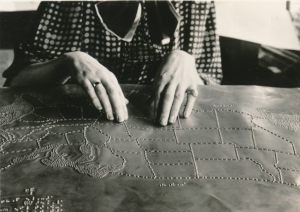
A WPA Braille Map at the Perkins Institute for the Blind, Watertown, Massachusetts, 1936. Courtesy, NARA.
President Roosevelt was not a dispassionate observer of these efforts. In a 1935 telephone call he congratulated the American Foundation for the Blind on the dedication of its new Administration Building in New York, saying he was proud of his association with Helen Keller, whom he would later make chairman of a federal committee to promote goods made by the blind. Keller, blind and deaf since childhood, worked for the foundation for more than forty years.

Blind adults in Atlanta, Georgia learn to read and write Braille. Courtesy, NARA.
FDR also said he considered it “a privilege to have a part in aiding the betterment of conditions for those who have been handicapped by lack of vision and, when I say lack of vision, I mean it in the purely physical sense, because people who are blind certainly have a splendid vision in every other way.”
Brent McKee is a Living New Deal Research Associate (the first, in fact!) and a core member of the LND team. He lives in West Virginia.







